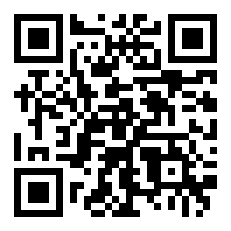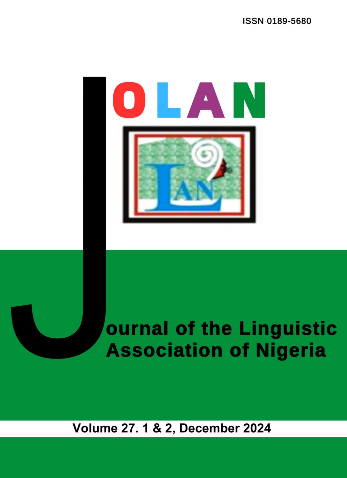Preliminary Pages
Abstract
Editorial
On behalf of the Editorial Committee of the Journal of Linguistic Association of Nigeria, (JOLAN), I am glad to announce the publication of the latest issue of the journal, Volume 27 Numbers 1&2 (2024). This collection highlights contemporary debates in the field of linguistics particularly about language faculty. It provides insights into current and future directions of research in the field. The papers were carefully selected on the basis of their scholarly standing, scientific quality and theoretical implications which shed light on the nature of language. This volume, as usual, offers interdisciplinary trajectory on the general state and direction in the field of linguistic research. The volume aims to advance knowledge of how language works, and how linguistic insights may be applied practically across spectrum of social concerns like humour, advertising, education and disease coding and classification. Significantly, it has revealed important corollaries about the nature of language in representing the state of the mind. This collection offers the most up-to-date information vital to the full understanding of language in both practical and theoretical terms. The vivid and informed analyses provided by the contributors will guide anyone seeking to improve their teaching, writing and/or research skills whether through a formal context or on their own.
There are nine well-researched and evaluated articles that are published in this volume. Six of the papers are in the area of structural linguistics and three papers are in applied linguistics. All the papers intend to stimulate discussion and promote understanding of ideas and concepts in contemporary linguistics across Nigeria and Ghana. In the first article, Asuoha examines the syntax of connectives in Ngwa (Igbo) from the theoretical lens of X-bar model. The main argument of the paper is that some coordinating
conjunctions cannot be used in the first position of a sentence, and some connectors cannot be used in the last position of a sentence when they introduce no clause. Certain conjoining words can be employed as both coordinating and subordinating conjunctions since they serve overlapping purposes depending on the kind of structure they join. Okon and others investigate argument preposing in the Ibibio language from the theoretical context of Chomsky’s minimalist program. The paper maintains that argument preposing is a focus
strategy particularly when it is analysed from its base-generated position to a case feature position and then to the left periphery of the sentence. In another syntactic inquiry, Asante investigates the transition of a future tense marker from the status of a motion verb into a
grammatical marker. A common belief that motion verbs are a rich source concepts for obtaining grammatical indicators of temporal orientation is reinforced by this derivation.
Erin and Fwangwar’s paper explores the concept of reduplication in the Mwaghavul language. The study's conclusions show that reduplication, combines with tone shifts in some cases, linguistically indicates mood in some verbs, intensification/emphasis in adjectival verbs, distributiveness in cardinal numerals, and relativity in colour adjectives. In this way, reduplication in Mwaghavul is triggered by both phonological and morphosyntactic processes. Olennu and colleagues examine the syntax of the Book of Proverbs in the Ga language in Ghana. The paper suggests that the Book of Proverbs in the Ga Bible attests to the parallelism patterns that the Hebrew scholars found in the composition of ancient poetry. The only paper on phonology is “Vowel length in Anaañ” by Eyakndue. The article argues that vowel lengthening is a widespread feature in Anaañ, and is mostly employed for plurality, emphasis, and lexical and grammatical differences. Fakoya and Bamgbose investigate the relationship between impoliteness, humour and roadside advertising of herbal medicine in Lagos State, Nigeria. The study demonstrates the effectiveness of the marketers' use of impolite language while also emphasizing three key discourse types that the public is expected to be familiar with: proactive, curative, and preventive. These strategies all relate to and reveal the psycho-social concerns and interests of the consumers of these products.
A lexical-semantic compilation of wordlist of illnesses, diseases and global pandemic in Abureni is the focus of Etire’s article in this volume. The linguistic strategies of constructing disease names including historical events, traditional beliefs, orthodox and traditional medicine, sociocultural values, and native fauna species. The study concludes that knowledge of disease names is fundamental for proper diagnoses which is a prerequisite for every medical treatment. The last paper is concerned with student-teachers’ competence in the use of new technology in teaching and learning English grammar in the contexts of a higher institution in Nigeria. The results demonstrate that the student-teachers lack the technological proficiency and favorable attitudes necessary to apply modern technology for grammar instruction.
The volume provides new insights to linguistic research through a close analysis of West African languages’ structures and their application in a wider social, medical and educational context. It is simply unputdownable.
Downloads
Published
How to Cite
Issue
Section
License
Copyright (c) 2024 Journal of The Linguistic Association of Nigeria

This work is licensed under a Creative Commons Attribution-NonCommercial-ShareAlike 4.0 International License.













